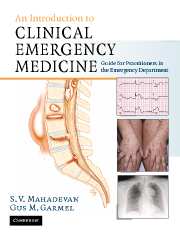Book contents
- Frontmatter
- Contents
- List of contributors
- Foreword
- Acknowledgments
- Dedication
- Section 1 Principles of Emergency Medicine
- Section 2 Primary Complaints
- 9 Abdominal pain
- 10 Abnormal behavior
- 11 Allergic reactions and anaphylactic syndromes
- 12 Altered mental status
- 13 Chest pain
- 14 Constipation
- 15 Crying and irritability
- 16 Diabetes-related emergencies
- 17 Diarrhea
- 18 Dizziness and vertigo
- 19 Ear pain, nosebleed and throat pain (ENT)
- 20 Extremity trauma
- 21 Eye pain, redness and visual loss
- 22 Fever in adults
- 23 Fever in children
- 24 Gastrointestinal bleeding
- 25 Headache
- 26 Hypertensive urgencies and emergencies
- 27 Joint pain
- 28 Low back pain
- 29 Pelvic pain
- 30 Rash
- 31 Scrotal pain
- 32 Seizures
- 33 Shortness of breath in adults
- 34 Shortness of breath in children
- 35 Syncope
- 36 Toxicologic emergencies
- 37 Urinary-related complaints
- 38 Vaginal bleeding
- 39 Vomiting
- 40 Weakness
- Section 3 Unique Issues in Emergency Medicine
- Section 4 Appendices
- Index
16 - Diabetes-related emergencies
Published online by Cambridge University Press: 27 October 2009
- Frontmatter
- Contents
- List of contributors
- Foreword
- Acknowledgments
- Dedication
- Section 1 Principles of Emergency Medicine
- Section 2 Primary Complaints
- 9 Abdominal pain
- 10 Abnormal behavior
- 11 Allergic reactions and anaphylactic syndromes
- 12 Altered mental status
- 13 Chest pain
- 14 Constipation
- 15 Crying and irritability
- 16 Diabetes-related emergencies
- 17 Diarrhea
- 18 Dizziness and vertigo
- 19 Ear pain, nosebleed and throat pain (ENT)
- 20 Extremity trauma
- 21 Eye pain, redness and visual loss
- 22 Fever in adults
- 23 Fever in children
- 24 Gastrointestinal bleeding
- 25 Headache
- 26 Hypertensive urgencies and emergencies
- 27 Joint pain
- 28 Low back pain
- 29 Pelvic pain
- 30 Rash
- 31 Scrotal pain
- 32 Seizures
- 33 Shortness of breath in adults
- 34 Shortness of breath in children
- 35 Syncope
- 36 Toxicologic emergencies
- 37 Urinary-related complaints
- 38 Vaginal bleeding
- 39 Vomiting
- 40 Weakness
- Section 3 Unique Issues in Emergency Medicine
- Section 4 Appendices
- Index
Summary
Scope of the problem
Diabetes mellitus affects an estimated 11 million people in the US and over 100 million worldwide. Approximately 90% of these patients have type 2 or non-insulin-dependent diabetes. The remainder are classified as type 1 or insulin-dependent diabetics.
Diabetes is characterized by chronic hyperglycemia that often requires lifelong treatment. Untreated, chronic hyperglycemia eventually leads to both micro- and macrovascular complications affecting virtually every organ system. As a result, diabetics frequently present to the emergency department (ED) with complications such as severe infections, myocardial infarction (MI), stroke, renal disease, and lower extremity ischemia and skin ulcerations.
This chapter focuses on the diagnosis and management of acute metabolic derangements frequently encountered in diabetic patients. These consist of diabetic ketoacidosis (DKA), hyperglycemic hyperosmolar state (HHS), and hypoglycemia.
Diabetic ketoacidosis
DKA is a potentially life-threatening medical emergency. It occurs predominantly in type 1 diabetics and accounts for the initial presentation of glucose-related problems in about 25% of diabetics. Despite advances in treatment, the mortality rate for this condition remains 2–4%.
DKA is a syndrome characterized by hyperglycemia, ketonemia, and metabolic acidosis caused by either relative or absolute insulin deficiency. The treatment consists of fluid and electrolyte replacement, together with continuous low-dose insulin infusion.
Precipitating causes for DKA include infection, MI, trauma, pregnancy, or stress. In many cases, there isn't an intercurrent disease process, and noncompliance with insulin therapy is recognized as a significant precipitant of DKA. Errors of insulin dosage may occasionally be a contributing factor.
- Type
- Chapter
- Information
- An Introduction to Clinical Emergency MedicineGuide for Practitioners in the Emergency Department, pp. 225 - 232Publisher: Cambridge University PressPrint publication year: 2005

